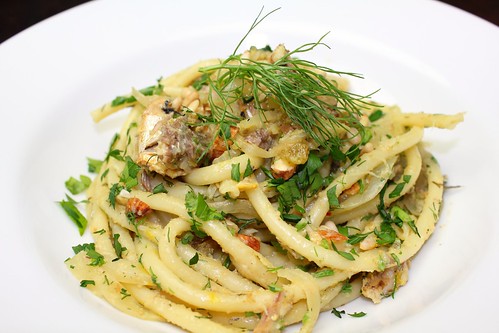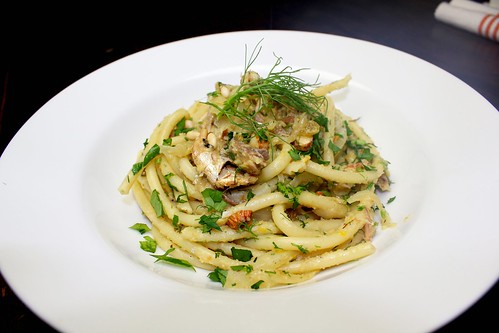Greeks, Romans, Moors, Normans, Spaniards, Garibaldi and his thousand, and finally hordes of tourists have visited Sicily over the milennia. Some stayed for centuries, some only for generations, but even those whose sojourn was comparatively brief played a role in the island’s blending of cultures and traditions.
If this human concoction can be distilled into a single dish, it might be pasta con le sarde. A strikingly simple plate of spaghetti, fennel, onions, and sardines garnished with golden raisins (sultanas) and pine nuts, but its layers of flavor and texture speak of Sicily’s multifarious heritage. Grapes, introduced by the Greeks in the 7th century BC, combining with the tradition of using dried fruit in savory dishes adopted from the Moors, the abundant use of saffron borrowed from the Spanish Bourbon monarchy, and the native reliance on cheap and readily-available ingredients of the highest quality in the onions, foraged wild fennel, pine nuts and the island’s golden olive oil.
And, just like the variegated Sicilian identity, the disagreements over what constitutes a real pasta con le sarde are multihued. Some prefer a thicker long pasta like perciatelli or bucatini over spaghetti, some add breadcrumbs, some refuse to add anchovies, others only saute half the sardines with the sauce, breaking the other half into mix after the pasta has been added to the pan, and yet others would crumble almonds over the assembled dish and bake it in a moderate oven for 20 minutes. The biggest philosophical difference though, lies in the presence of tomato paste. Palermitano’s typically leave it out altogether, whereas cooks further west and south in Trappani, Marsala and, particularly Agrigento, would claim it as an essential ingredient.
Ever the diplomats, we (probably to the aggravation of native Sicilians) chose the middle ground, and elected to use anchovies and bucatini, leave out the tomato paste, cook all the sardines in the sauce, and add both breadcrumbs and broken almonds, but we chose not to bake it. It was wonderful: crunchy, salty and sweet, and with a profound maritime flavor overlaid perfectly by the fennel.
Those of you with an aversion to small oily fish should probably avoid this dish completely for substitutions of whiter, milder species cannot be recommended, unless even greater Sicilian wrath is desired. And, if encouragement to try something different is needed, look no further than the twin factors of wholesomeness and economy. Sardines and pasta are still very affordable, and, for us, halfway through a month-long meatless regimen ahead of a warm weather vacation, it checked all the taste and healthful boxes.
It also checked the seasonal box, for, strictly-speaking, this dish should only be eaten between March and September when wild fennel can be found extending its spidery fronds all over the island’s uplands. For those of us without wild ingredients to hand, or such a favorable climate, cultivated fennel plus a scant 1/4 teaspoon of ground fennel seeds (or a smaller quantity of fennel pollen), provide a similar perfume.
Please note that one should always use the freshest possible sardines, and not just for this recipe. The oilier the fish, the shorter the shelf life – hence why anchovies are so often salted and in oil – and the general rule of thumb is 8-12 hours out of water is about as long as it takes for sardines to go from glorious to gory mess. You can certainly freeze them too, but like most fish, especially small ones, the defrosting process has to be slow and delicate to prevent them from getting mushy.
Ingredients
- 1lb (1/2 kilo) dried long pasta (spaghetti, bucatini, perciatelli)
- 1 fennel bulb, tops removed and reserved, sliced wafer thin
- 1 medium yellow onion, sliced thinly
- 3-4 cloves garlic, finely sliced.
- 4-6 medium sardines (1lb / 1/2 kilo), cleaned and boned
- handful golden raisins (sultanas)
- handful pine nuts (pignoli)
- 1 small glass dry white wine
- 2 handfuls day-old bread crumbs
- 1 handful roughly chopped almonds
- 3 salted anchovies
- 1 pinch saffron
- freshly ground black pepper
- sea salt to taste
- good quality olive oil
- chopped flat leaf parsley (optional)
Recipe:
- Bring a large pot of salted water to a rolling boil
- In a saute pan, bring 3 tablespoons of olive oil to medium heat
- Saute onions, garlic and fennel (not including reserved tops) until softened.
- Add sardines and anchovies, stir to break up anchovies.
- Turn heat to high and after 30 seconds add white wine and saffron.
- Stir again, reduce heat to low after 1 minute. Cover for 5 minutes and allow to steam.
- Add pasta to large pot of salted water.
- Remove of saute pan lid, stir sardines so fish starts to flake and fall apart into the sauce.
- Add golden raisins and pine nuts. Taste for seasoning, correct accordingly.
- When pasta is done – around 7 minutes – scoop a ladle of pasta water into sardine sauce before draining pasta and adding it to saute pan.
- Stir pasta well to coat with sauce. Allow to cook for another minute
- Kill heat, and sprinkle in breadcrumbs, chopped almonds, fennel tops and chopped parsley (optional).
- Stir well and serve with a chilled glass of the same wine.
*Credit should be given to Ferdinando’s Focacceria for inspiring us to cook this dish.


Gosh, I haven’t had this in years… what a glorious dish it is… gutsy and full of flavor. Brilliant idea to put in the fennel pollen… not used nearly enough. Great dish with great history.
Nice pasta. I like the thick long noodles.
I love fresh sardines and I look forward to having then again each time the summers in Greece near. Great looking Sicilian classic.
Oh how I love this dish! Not that it needs it, but a little toasted breadcrumbs on top is molto bene too. 🙂
Hi Guys, See I do read your posts! This is a recipe even I could handle! And one that Frank Senior would have enjoyed ~ he loved sardines & anchovies! I look forward to trying it. ~k
This looks absolutely incredible… I love the idea of golden raisins. And the thick pasta looks so tasty!
I love the culinary history lessons you almost always include in your posts. Wish I could find fresh sardines around here- every once in a while they come around but it’s pretty infrequent.
What a gorgeous, gorgeous dish. I love everything in it, though I’d never’ve thought to pair sardines with that flavor profile. WE have lots of feral fennel all over my neighborhood – its favorite habitat, like hobos, seems to be rail yards and gravel parking lots.
@Heather – oh yeah, fennel and sardines is the bomb. Sicilians also do sarde ripiene (stuffed sardines) with almost the same ingredients, minus the pasta.
@Peter – figured we’d grab you with the sardines and the mention of the Greeks!
@Noelle – you’re welcome! we love a side of history with our dinner.
I used to only make Pasta con Sarde for my husband on St. Joseph’s Day in March, however, I make it for most Sunday dinners lately. Those breadcrumbs and currants make the dish so good.
I am addicted to sardines lately. I have a sardine taste test on my blog coming up this week (Portugal wins).
(That’s why I am so brainy, I eat them everyday).
I’ve been drawn to every sardine dish I see lately, and the Sicily story in the March Saveur is making me constantly think of their food. So, I need this for dinner tonight. I think I’d make the same choices you did. Breadcrumbs yes but no tomato paste and no baking sound good to me.
we’re definitely going to be trying this. i’m on a mission to eat more sardines.
I often crave fresh sardines. In fact I often crave them from January to December. Living in the UK means I don’t often get to satisfy my craving unless I want to settle fro the defrosted slimy version. This dish is incredible. Love the way you described all the influences on Sicilian cooking, a gastronomic identity in itself and which further emphasises to me the idea that there is no such thing as Italian food. Gonna have to hunt the internet for some sardines now. So want to try this. Have to say the oilier the fish the tastier it is as far as I’m concerned.
hey really very nice blog….what a glorious dish it is…m gng to try dis one….
Also like to share one news wid all my friends here which I came across on facebook. A luxury hotel is planting trees for every like on their facebook page. click on this link http://www.facebook.com/TheLaLit.Hotels.Palaces.and.Resorts and for every like on it, one tree will be planted. Do your bit guys to save environment…
My Grandmother was born in a town outside Palermo. My mother made this every St. Joseph’s Day. She made it with toasted breadcrumbs on top and baked a few minutes in the oven. So happy to find it on your web site.
I forgot to add that we always use Mafaldi pasta. It is long, thicker than most pasta, is about 1/4 inch wide and has curly ends like a lasagna does. It works very well with the sauce.
@Jacqueline: thanks so much for visiting and your sharing your family story!